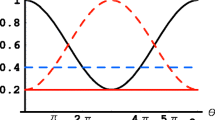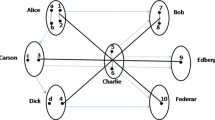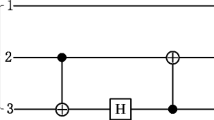Abstract
In this paper, we use a quantum channel that is the product of two states, the four-qubit cluster state and the three-qubit partially entangled state. This quantum channel is used as a channel in the two controlled teleportation protocols of an arbitrary two-qubit state. When the controller cooperates, both of these protocols are perfect, i.e., the total success probability and the quantum fidelity of the state received by the receiver are equal to 1. In the two controlled teleportation protocols, the number of qubits held by the controller is the same. However, depending on how the qubits in the channel are distributed to the controller, the controller’s power may be entirely in or below the quantum domain. Thus, the controller’s power is guaranteed when the qubits in the quantum channel are correctly distributed. On the other hand, we also show that the controller’s power depends on the entanglement of the qubits that the controller holds with the rest of the qubits in the channel.





Similar content being viewed by others
Data availability
The authors confirm that the data supporting the findings of this study are available within the article.
References
Bennett, C.H., Brassard, G., Crepeau, C., Jozsa, R., A., Wootters, W.K.: Teleporting an unknown quantum state via dual classical and einstein-podolsky-rosen channels. Phys. Rev. Lett. 72, 1895 (1993). https://doi.org/10.1103/PhysRevLett.70.1895
Nielsen, M.A., Chuang, I.L.: Quantum Computation and Quantum Information. Cambridge University Press, Cambridge (2000)
Braunstein, S.L., Kimble, H.J.: Teleportation of continuous quantum variables. Phys. Rev. Lett. 80, 869 (1998). https://doi.org/10.1103/PhysRevLett.80.869
Adesso, G., Illuminati, F.: Equivalence between entanglement and the optimal fidelity of continuous variable teleportation. Phys. Rev. Lett. 95, 150503 (2005). https://doi.org/10.1103/PhysRevLett.95.150503
Dell’Anno, F., Siena, S.D., Albano, L., Illuminati, F.: Continuous-variable quantum teleportation with non-gaussian resources. Phys. Rev. A 76, 022301 (2007). https://doi.org/10.1103/PhysRevA.76.022301
Adhikari, S., Majumdar, A.S., Nayak, N.: Teleportation of two-mode squeezed states. Phys. Rev. A 77, 012337 (2008). https://doi.org/10.1103/PhysRevA.77.012337
Adhikari, S., Majumdar, A.S., Roy, S., Ghosh, B., Nayak, N.: Teleportation via maximally and nonmaximally entangled mixed states. Quantum Inf. Comput 10, 0398 (2010). https://doi.org/10.26421/QIC10.5-6-3
Ganguly, N., Adhikari, S., Majumdar, A.S., Chatterjee, J.: Entanglement witness operator for quantum teleportation. Phys. Rev. Lett. 107, 270501 (2011). https://doi.org/10.1103/PhysRevLett.107.270501
Adhikari, S., Majumdar, A.S., Home, D., Pan, A.K., Joshi, P.: Quantum teleportation using nonorthogonal entangled channels. Phys. Scr 85(4), 045001 (2012). https://doi.org/10.1088/0031-8949/85/04/045001
Sazim, S., Adhikari, S., Banerjee, S., Pramanik, T.: Quantification of entanglement of teleportation in arbitrary dimensions. Quantum Inf. Process 13, 863–880 (2014). https://doi.org/10.1007/s11128-013-0697-3
Liu, D., Huang, Z., Guo, X.: Probabilistic teleportation via quantum channel with partial information. Entropy 17(6), 3621–3630 (2015). https://doi.org/10.3390/e17063621
Kiktenko, E.O., Popov, A.A., Fedorov, A.K.: Bidirectional imperfect quantum teleportation with a single bell state. Phys. Rev. A. 93, 062305 (2016). https://doi.org/10.1103/PhysRevA.93.062305
Cavalcanti, D., Skrzypczyk, P., Šupic, I.: All entangled states can demonstrate nonclassical teleportation. Phys. Rev. Lett. 119, 110501 (2017). https://doi.org/10.1103/PhysRevLett.119.110501
Jeongho, B., Junghee, R., Kaszlikowski, D.: Fidelity deviation in quantum teleportation. J. Phys. A Math. Theor. 51(13), 135302 (2018). https://doi.org/10.1088/1751-8121/aaac35
Quan, Q., Zhao, M.J., Fei, S.M., Fan, H., Yang, W.L., Long, G.L.: Two-copy quantum teleportation. Sci. Rep. 8, 13960 (2018). https://doi.org/10.1038/s41598-018-31918-0
Bouwmeester, D., Pan, J., W., Mattle, K., Eibl, M., Weinfurter, H., Zeilinger, A.: Experimental quantum teleportation. Nature 390, 575–579 (1997). https://doi.org/10.1038/37539
Boschi, D., Branca, S., Martini, F.D., Hardy, L., Popescu, S.: Experimental realization of teleporting an unknown pure quantum state via dual classical and Einstein–Podolsky–Rosen channels. Phys. Rev. Lett. 80, 1121 (1998). https://doi.org/10.1103/PhysRevLett.80.1121
Furusawa, A., Sørensen, J.L., Braunstein, S.L., Fuchs, C.A., Kimble, H.J., Polzik, E.S.: Unconditional quantum teleportation. Science 282, 706–709 (1998). https://doi.org/10.1126/science.282.5389.706
Zhang, T.C., Goh, K.W., Chou, C.W., Lodahl, P., Kimble, H.J.: Quantum teleportation of light beams. Phys. Rev. A 67, 033802 (2003). https://doi.org/10.1103/PhysRevA.67.033802
Takei, N., Yonezawa, H., Aoki, T., Furusawa, A.: High-fidelity teleportation beyond the no-cloning limit and entanglement swapping for continuous variables. Phys. Rev. Lett. 94, 220502 (2005). https://doi.org/10.1103/PhysRevLett.94.220502
DiGuglielmo, J., Hage, B., Franzen, A., Fiurášek, J., Schnabel, R.: Experimental characterization of gaussian quantum-communication channels. Phys. Rev. A 76, 012323 (2007). https://doi.org/10.1103/PhysRevA.76.012323
Xiao, S.M., Herbst, T., Scheidl, T., Wang, D., Kropatschek, S., Naylor, W., Wittmann, B., Mech, A., Kofler, J., Anisimova, E., Makarov, V., Jennewein, T., Ursin, R., Zeilinger, A.: Quantum teleportation over 143 kilometres using active feed-forward. Nature 489, 269–273 (2012). https://doi.org/10.1038/nature11472
Wang, X.L., Cai, X.D., Su, Z.E., Chen, M.C., Wu, D., Li, L., Liu, N.L., Lu, C.Y., Pan, J.W.: Quantum teleportation of multiple degrees of freedom of a single photon. Nature 518, 516–519 (2015). https://doi.org/10.1038/nature14246
Valivarthi, R., Puigibert, M., Zhou, Q., Aguilar, G.H., Verma, V.B., Marsili, F., Shaw, M.D., Nam, S.W., Oblak, D., Tittel, W.: Quantum teleportation across a metropolitan fibre network. Nat. Photonics 10, 676–680 (2016). https://doi.org/10.1038/nphoton.2016.180
Karlsson, A., Bourennane, M.: Quantum teleportation using three-particle entanglement. Phys. Rev. A 58, 4394 (1998). https://doi.org/10.1103/PhysRevA.58.4394
Yang, C.P., Chu, S.I., Han, S.: Efficient many-party controlled teleportation of multiqubit quantum information via entanglement. Phys. Rev. A 70, 022329 (2000). https://doi.org/10.1103/PhysRevA.70.022329
Deng, F.G., Li, C.Y., Li, Y.S., Zhou, H.Y., Wang, Y.: Symmetric multiparty-controlled teleportation of an arbitrary two-particle entanglement. Phys. Rev. A 72, 022338 (2005). https://doi.org/10.1103/PhysRevA.72.022338
Man, Z.X., Xia, Y.J., An, N.B.: Genuine multiqubit entanglement and controlled teleportation. Phys. Rev. A 75, 052306 (2007). https://doi.org/10.1103/PhysRevA.75.052306
Medina, I., Semião, F.: Transmission losses in optical qubits for controlled teleportation. Quantum Inf. Process. 16, 235 (2017). https://doi.org/10.1007/s11128-017-1684-x
Barasiński, A., Arkhipov, I.I., Svozilík, J.: Localizable entanglement as a necessary resource of controlled quantum teleportation. Sci Rep 8, 15209 (2018). https://doi.org/10.1038/s41598-018-33185-5
Barasiński, A., Černoch, A., Lemr, K.: Demonstration of controlled quantum teleportation for discrete variables on linear optical devices. Phys. Rev. Lett. 122, 170501 (2019). https://doi.org/10.1103/PhysRevLett.122.170501
Zarmehi, F., Kochakzadeh, M.H., Abbasi-Moghadam, D., et al.: Efficient circular controlled quantum teleportation and broadcast schemes in the presence of quantum noises. Quantum Inf Process 20, 175 (2021). https://doi.org/10.1007/s11128-021-03088-y
Bich, C.T., An, N.B.: Hierarchically controlling quantum teleportations. Quantum Inf Process 18, 245 (2019). https://doi.org/10.1007/s11128-019-2355-x
Kumar, A., Haddadi, S., Pourkarimi, M.R., et al.: Experimental realization of controlled quantum teleportation of arbitrary qubit states via cluster states. Sci Rep 10, 13608 (2020). https://doi.org/10.1038/s41598-020-70446-8
Huo, G., Zhang, T., Zha, X., et al.: Controlled asymmetric bidirectional quantum teleportation of two- and three-qubit states. Quantum Inf Process 20, 24 (2021). https://doi.org/10.1007/s11128-020-02956-3
Li, Xi-Han., Ghose, S.: Control power in perfect controlled teleportation via partially entangled channels. Phys. Rev. A 90, 052305 (2014). https://doi.org/10.1103/PhysRevA.90.052305
Li, Xi-Han., Ghose, S.: Analysis of n-qubit perfect controlled teleportation schemes from the controller’s point of view. Phys. Rev. A 91, 012320 (2015). https://doi.org/10.1103/PhysRevA.91.012320
Jiang, Yt., Mo, Zw.: Comparison and analysis of the control power between two different perfect controlled teleportation schemes using four-particle cluster state. Int J Theor Phys 56, 3084–3091 (2017). https://doi.org/10.1007/s10773-017-3474-8
Zha, X.-W., Jiang, R.-X.., Wang, M..-R.: Analyzing four-qubit cluster state entanglement symmetry property via control power. Int J Theor Phys 58, 1499–1508 (2019). https://doi.org/10.1007/s10773-019-04036-4
Barasiński, A., Svozilík, J.: Controlled teleportation of qubit states: Relation between teleportation faithfulness, controller’s authority, and tripartite entanglement. Phys. Rev. A 99, 012306 (2019). https://doi.org/10.1103/PhysRevA.99.012306
Faujdar, J., Kumar, A.: A comparative study to analyze efficiencies of (N+2)-qubit partially entangled states in real conditions from the perspective of n controllers. Quantum Inf Process 20, 64 (2021). https://doi.org/10.1007/s11128-021-02993-6
Hop, V.N., Bich, C.T., An, N.B.: On the role of the controller in controlled quantum teleportation. Int J Theor Phys 56, 810–821 (2017). https://doi.org/10.1007/s10773-016-3224-3
Hou, K., Bao, Dq., Zhu, Cj., et al.: Controlled teleportation of an arbitrary two-qubit entanglement in noises environment. Quantum Inf Process 18, 104 (2019). https://doi.org/10.1007/s11128-019-2218-5
Briegel, H.J., Raussendorf, R.: Persistent entanglement in arrays of interacting particles. Phys. Rev. Lett. 86, 910 (2001). https://doi.org/10.1103/PhysRevLett.86.910
Kiesel, N., Schmid, C., Weber, U., Tóth, G., Gühne, O., Ursin, R., Weinfurter, H.: Experimental analysis of a four-qubit photon cluster state. Phys. Rev. Lett. 95, 210502 (2005). https://doi.org/10.1103/PhysRevLett.95.210502
Park, H.S., Cho, J., Lee, J.Y., Lee, D.H., Choi, S.K.: Two-photon four-qubit cluster state generation based on a polarization-entangled photon pair. Optics Express. 15(26), 17960–17966 (2007). https://doi.org/10.1364/OE.15.017960
Zyczkowski, K., Sommers, H.-J.: Induced measures in the space of mixed quantum states. J. Phys. A 34(35), 7111 (2001). https://doi.org/10.1088/0305-4470/34/35/335
Coffman, V., Kundu, J., Wootters, W.K.: Distributed entanglement. Phys. Rev. A 61, 052306 (2000). https://doi.org/10.1103/PhysRevA.61.052306
Wang, T.-J., Ghose, S.: Control power of quantum channels is not multiplicative. New J. Phys. 22, 123046 (2020). https://doi.org/10.1088/1367-2630/abd206
Sakurai, J.J.: Modern Quantum Mechanics. Addison Wesley Publishing Company, Boston (1994)
Acknowledgements
This works is supported by the Vietnam Ministry of Education and Training under Grant Number B2022-SPH-16.
Author information
Authors and Affiliations
Corresponding author
Ethics declarations
Conflict of interest
The authors declare no conflict of interest.
Additional information
Publisher's Note
Springer Nature remains neutral with regard to jurisdictional claims in published maps and institutional affiliations.
Appendix
Appendix
This appendix presents a mathematical description of the steps performed in the two protocols.
Protocol 1 According to the distribution of qubits of the cluster state (3) of protocol 1, we can write the expression of this cluster state as follows
The results of protocol 1 do not depend on whether the sender Alice first performs the Bell measurements or the controller Charlie first performs the measurements because these measurements are independent of each other. To give the expression of state (30) a simple form, we assume that, the first the controller Charlie applies the operator \(CZ_{C_{1}C_{2}}\) to the pair of qubits \(C_{1}\) and \(C_{2},\) then equation (30) becomes
Using the Bell state formulas
then state (31) is rewritten as follows
and state (4) becomes
in there
The general state of the two qubits to be teleported (1) can be rewritten as
in there
Then, the product state of the two qubits to be teleported and the quantum channel of protocol 1 can be expressed as
Using the Bell state formula (32) and the inverse transformation of the form
the equation (38) is rewritten as
When the controller Charlie applies the rotation gate \(R\left( -\theta \right) \) to qubit \(C_{3},\) equation (35) becomes
After the controller Charlie applies the rotation gate \(R\left( -\theta \right) \) to qubit \(C_{3}\), the state (40) becomes
in there \(\beta _{0}=\cos \theta /2\), \(\beta _{1}=\sin \theta /2.\)
It is clear from equation (42) that if Alice makes two Bell-state measurements on the pairs of qubits \(\left( XA_{1}\right) \), \(\left( YA_{2}\right) \) with outcomes \(\left\{ ij\right\} \), \(\left\{ kl\right\} \) corresponding to finding \(\left| B_{ij}\right\rangle _{XA_{1}}\), \(\left| B_{kl}\right\rangle _{YA_{2}}\). Charlie makes Bell-state measurement on the pair of qubits \(\left( C_{1}C_{2}\right) \) with outcomes \(\left\{ mn\right\} \) corresponding to finding \(\left| B_{mn}\right\rangle _{C_{1}C_{2}}\). Charlie measures qubit \(C_{3}\) in the computational basis \(\left\{ \left| 0\right\rangle _{C_{3}},~\left| 1\right\rangle _{C_{3}}\right\} \) with an outcome \(\left\{ p\right\} \) corresponding to finding \(\left| p\right\rangle _{C_{3}}\), then the state of Bob’s qubits \(B_{1}\) and \(B_{2}\), up to a global phase factor \(\left( -1\right) ^{mj\oplus pl}\), is projected onto
The measurement results of Alice \(\left( \left\{ ij\right\} \text {, }\left\{ kl\right\} \right) \) and Charlie \(\left( \left\{ mn\right\} \text {, }\left\{ p\right\} \right) \) are sent to the receiver Bob over the classical communication channel. To transform state (43) to the original state that Alice wants to send, equation (1), Bob acts on qubits \(B_{1}\) and \(B_{2}\), the unitary recovery operator, which is determined by the following expression
The probability of Alice and Charlie’s respective measurements is
The total success probability of protocol 1 is
Protocol 2 According to the distribution of qubits of the cluster state in equation (3) of protocol 2, we can write this cluster state as follows
State (4) still has the same form as equation (34) in protocol 1. Then, the product state of the two qubits to be teleported and the quantum channel of protocol 2 can be expressed as
Using the formula for the Bell state (32) and the inverse transformation (39), the state (48) can be rewritten as:
After the controller Charlie applies the rotation gate \(R\left( \theta \right) \) to qubit \(C_{3}\), the state (49) becomes
It is now clear from equation (50) that if Alice makes two Bell-state measurements on the pairs of qubits \(\left( XA_{1}\right) \), \(\left( YA_{2}\right) \) with outcomes \(\left\{ ij\right\} \), \(\left\{ kl\right\} \) corresponding to finding \(\left| B_{ij}\right\rangle _{XA_{1}}\), \(\left| B_{kl}\right\rangle _{YA_{2}}\). Charlie measures qubits \(B_{1},\) \(C_{2}\) and qubit \(C_{3}\) on a computational basis \(\left\{ \left| 0\right\rangle ,\left| 1\right\rangle \right\} \) with an outcome \( \left\{ mn\right\} \left( n=m\right) \) and \(\left\{ p\right\} \) corresponding to finding \(\left| mm\right\rangle _{B_{1}C_{2}}\) and \( \left| p\right\rangle _{C_{3}}\), then the state of Bob’s qubits \(C_{1}\) and \(B_{2}\), up to a global phase factor \(\left( -1\right) ^{mj\oplus pl}\), is projected onto
The measurement results of Alice \(\left( \left\{ ij\right\} \text {, }\left\{ kl\right\} \right) \) and Charlie \(\left( \left\{ mn\right\} \text {, }\left\{ p\right\} \right) \) are sent to the receiver Bob over the classical communication channel. To transform state (51) to the original state that Alice wants to send, equation (1), Bob acts on qubits \(C_{1}\) and \(B_{2}\) the unitary recovery operator, which is determined by the following expression
The probability of Alice and Charlie’s respective measurements is
The total success probability of protocol 2 is
Rights and permissions
Springer Nature or its licensor (e.g. a society or other partner) holds exclusive rights to this article under a publishing agreement with the author(s) or other rightsholder(s); author self-archiving of the accepted manuscript version of this article is solely governed by the terms of such publishing agreement and applicable law.
About this article
Cite this article
Van, H.N. Enhancing the controller’s power in teleporting an arbitrary two-qubit state by using the asymmetry of the four-qubit cluster state. Quantum Inf Process 22, 135 (2023). https://doi.org/10.1007/s11128-023-03882-w
Received:
Accepted:
Published:
DOI: https://doi.org/10.1007/s11128-023-03882-w




